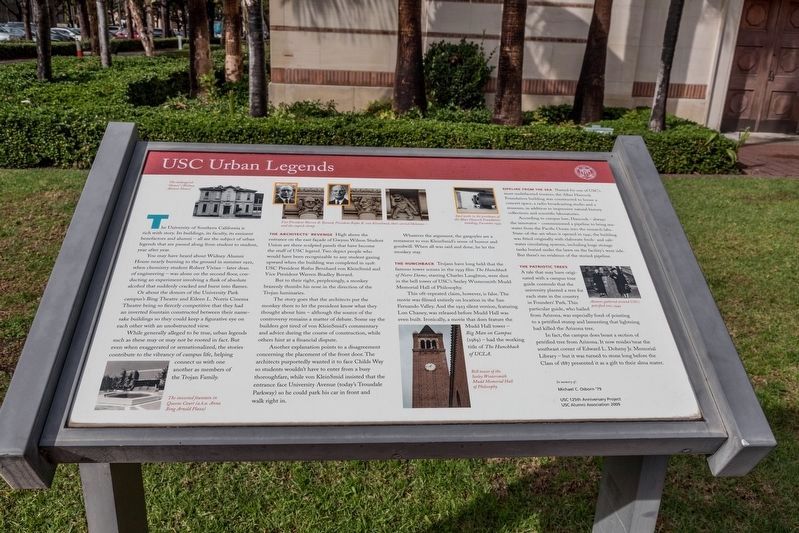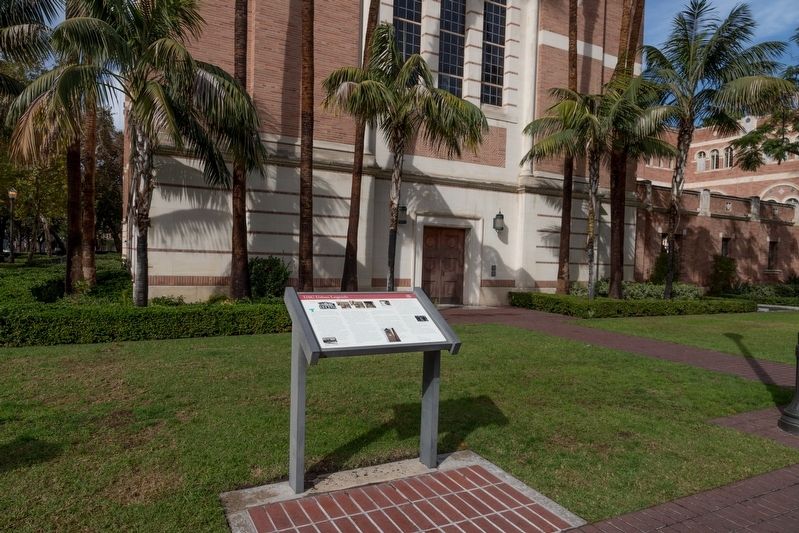South Los Angeles in Los Angeles County, California — The American West (Pacific Coastal)
USC Urban Legends
— USC — University of Southern California —
Inscription.
The University of Southern California is
rich with story. Its buildings, its faculty, its eminent
benefactors and alumni — all are the subject of urban
legends that are passed along from student to student,
year after year.
You may have heard about Widney Alumni
House nearly burning to the ground in summer 1922,
when chemistry student Robert Vivian — later dean
of engineering — was alone on the second floor, conducting an experiment involving a flask of absolute
alcohol that suddenly cracked and burst into flames.
Or about the donors of the University Park campus’s Bing Theatre and Eileen L. Norris Cinema Theatre being so fiercely competitive that they had an inverted fountain constructed between their namesake buildings so they could keep a figurative eye on each other with an unobstructed view.
While generally alleged to be true, urban legends such as these may or may not be rooted in fact. But even when exaggerated or sensationalized, the stories contribute to the vibrancy of campus life, helping connect us with one another as members of the Trojan Family.
The Architects’ Revenge. High above the entrance on the east facade of Gwynn Wilson Student Union are three sculpted panels that have become the stuff of USC legend. Two depict people who would have been recognizable to any student gazing upward when the building was completed in 1928: USC President Rufus Bernhard von KleinSmid and Vice President Warren Bradley Bovard.
But to their right, perplexingly, a monkey brazenly thumbs his nose in the direction of the Trojan luminaries.
The story goes that the architects put the monkey there to let the president know what they thought about him — although the source of the controversy remains a matter of debate. Some say the builders got tired of von KleinSmid’s commentary and advice during the course of construction, while others hint at a financial dispute.
Another explanation points to a disagreement concerning the placement of the front door. The architects purportedly wanted it to face Childs Way so students wouldn’t have to enter from a busy thoroughfare, while von KleinSmid insisted that the entrance face University Avenue (today’s Trousdale Parkway) so he could park his car in front and walk right in.
Whatever the argument, the gargoyles are a testament to von KleinSmid’s sense of humor and goodwill. When all was said and done, he let the monkey stay.
The Hunchback. Trojans have long held that the famous tower scenes in the 1939 film The Hunchback of Notre Dame, starring Charles Laughton, were shot in the bell tower of USC’s Seeley Wintersmith Mudd Memorial Hall of Philosophy.
This oft-repeated claim, however, is false. The movie was filmed entirely on location in the San Fernando Valley. And the 1923 silent version, featuring Lon Chaney, was released before Mudd Hall was even built. Ironically, a movie that does feature the Mudd Hall tower — Big Man on Campus (1989) — had the working title of The Hunchback of UCLA.
Pipeline from the Sea. Named for one of USC’s most multifaceted trustees, the Allan Hancock Foundation building was constructed to house a concert space, a radio broadcasting studio and a museum, in addition to impressive natural history collections and scientific laboratories.
According to campus lore, Hancock — always the innovator — commissioned a pipeline to bring seawater from the Pacific Ocean into the research labs. State-of-the-art when it opened in 1941, the building was fitted originally with elaborate fresh- and saltwater circulating systems, including huge storage tanks buried under the lawn on the facility’s west side.
But there's no evidence of the storied pipeline.
The Patriotic Trees. A tale that may have originated with a campus tour guide contends that the university planted a tree for each state in the country in Founders’ Park. This particular guide, who hailed from Arizona, was especially fond of pointing to a petrified stump and lamenting that lightning had killed the Arizona tree.
In fact, the campus does boast a section of petrified tree from Arizona. It now resides near the southeast corner of Edward L. Doheny Jr. Memorial Library — but it was turned to stone long before the Class of 1887 presented it as a gift to their alma mater.
Erected 2009 by USC 125th Anniversary Project, USC Alumni Association. In memory of Michael C. Osborn ’79.
Topics. This historical marker is listed in these topic lists: Education • Notable Buildings.
Location. 34° 1.186′ N, 118° 17.003′ W. Marker is in Los Angeles, California, in Los Angeles County. It is in South Los Angeles. Marker can be reached from the intersection of Childs Way and Argue Plaza. It is on the walkway that runs from Childs Way to Hellman Way past Argue Plaza. Between Edward L. Doheny Jr. Memorial Library and the Widney Alumni House. Marker faces Argue Plaza. Touch for map. Marker is in this post office area: Los Angeles CA 90089, United States of America. Touch for directions.
Other nearby markers. At least 8 other markers are within walking distance of this marker. Petrified Tree from the Arizona Forest (here, next to this marker); John C. Argue Plaza (here, next to this marker); The Oldest University Building in Southern California (within shouting distance of this marker); A Trojan for Life (within shouting distance of this marker); The Carolyn Craig Franklin Library Garden Courtyard and Fountain (within shouting distance of this marker); Endowing the Future (about 300 feet away, measured in a direct line); Doheny Memorial Library (about 300 feet away); Town and Gown of USC (about 400 feet away). Touch for a list and map of all markers in Los Angeles.
More about this marker. The interpretive panel contains a number of photographs and illustrations with the following captions (clockwise from upper left): The endangered “Annex” (Widney Alumni House). Vice President Warren B. Bovard, President Rufus B. von KleinSmid, their carved likenesses — and the impish chimp. Steel tanks in the penthouse of the Allan Hancock Foundation building, December 1939. Alumni gathered around USC’s petrified tree, 1949. Bell tower of the Seeley Wintersmith Mudd Memorial Hall of Philosophy. The inverted fountain in Queens Court (a.k.a. Anna Bing Arnold Plaza).
Also see . . . USC's First Book of Lists and Urban Legends. 2005 book compiled by Annette Moore on Amazon.com (Submitted on January 5, 2019.)
Credits. This page was last revised on January 30, 2023. It was originally submitted on January 5, 2019, by J. J. Prats of Powell, Ohio. This page has been viewed 995 times since then and 87 times this year. Last updated on January 9, 2019, by Craig Baker of Sylmar, California. Photos: 1, 2. submitted on January 5, 2019, by J. J. Prats of Powell, Ohio. • Andrew Ruppenstein was the editor who published this page.

